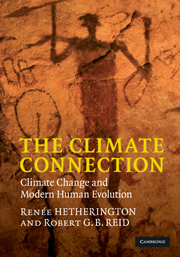Book contents
- Frontmatter
- Contents
- Foreword
- Preface
- Acknowledgements
- 1 Introduction
- Part I Early human history
- Part II Climate during the last glacial cycle
- Part III The interaction between climate and humans
- Appendices: The biological background to the story of evolution
- Appendix A Evolutionary theory
- Appendix B Developmental evolution
- Appendix C Human adaptability: the physiological foundation
- References
- Index
- Plate section
Appendix A - Evolutionary theory
Published online by Cambridge University Press: 05 August 2012
- Frontmatter
- Contents
- Foreword
- Preface
- Acknowledgements
- 1 Introduction
- Part I Early human history
- Part II Climate during the last glacial cycle
- Part III The interaction between climate and humans
- Appendices: The biological background to the story of evolution
- Appendix A Evolutionary theory
- Appendix B Developmental evolution
- Appendix C Human adaptability: the physiological foundation
- References
- Index
- Plate section
Summary
Aspects of evolutionary theory
Lamarckism
Before the end of the seventeenth century, little thought had been given to the possibility of evolution. Then, in eighteenth-century France, several biologist–philosophers began to revive Greek ideas about the origin of life, speculating about the phenomenon of adaptation, and the possibility that species might be mutable. Georges-Luis Leclerc de Buffon was the first to grasp the logic that if species were mutable there was no reason why they might not all have evolved from a simple, common ancestor. This influenced two important characters in the drama of evolutionary theory: Charles Darwin's grandfather Erasmus Darwin, and Jean-Baptiste Lamarck. Erasmus Darwin's 1794 book Zoonomia had a large chapter on evolution, and anticipated the ideas of the late nineteenth-century neo-Lamarckists. Lamarck found different inspiration in Buffonian evolution, publishing his thoughts in the 1809 book Philosophie zoologique, and in his subsequent books on invertebrate zoology.
Lamarck's most general precept was that evolution is a gradual, continuous gradation of organisms from the simple to the complex. This was the result of a progressive, inherent drive in all organisms. As organisms became more complex, they underwent adaptation to their way of life through the inheritance of acquired characteristics. Interestingly, Lamarck thought that adaptation could be in conflict with progressive complexification and slow the latter down.
The ‘four laws’ of Lamarckism are:
There is a general trend for an increase in size in evolutionary lineages. (This is often true, but not invariable. This law prompted little discussion or criticism.)
[…]
- Type
- Chapter
- Information
- The Climate ConnectionClimate Change and Modern Human Evolution, pp. 305 - 318Publisher: Cambridge University PressPrint publication year: 2010



